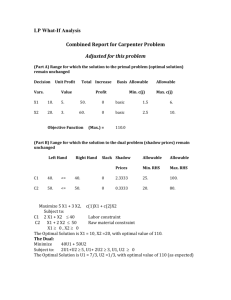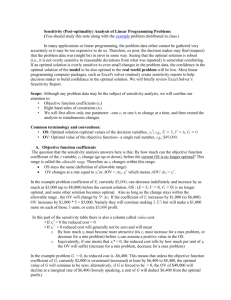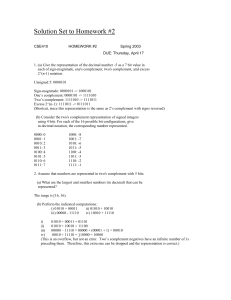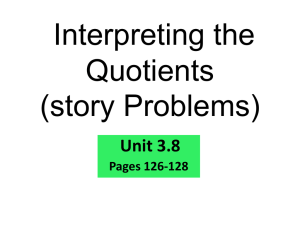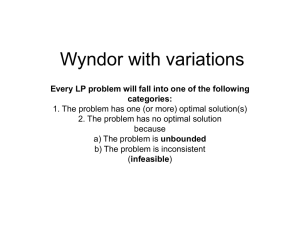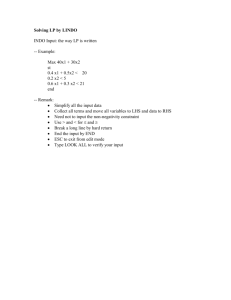Computer Managerial Interpretation
advertisement
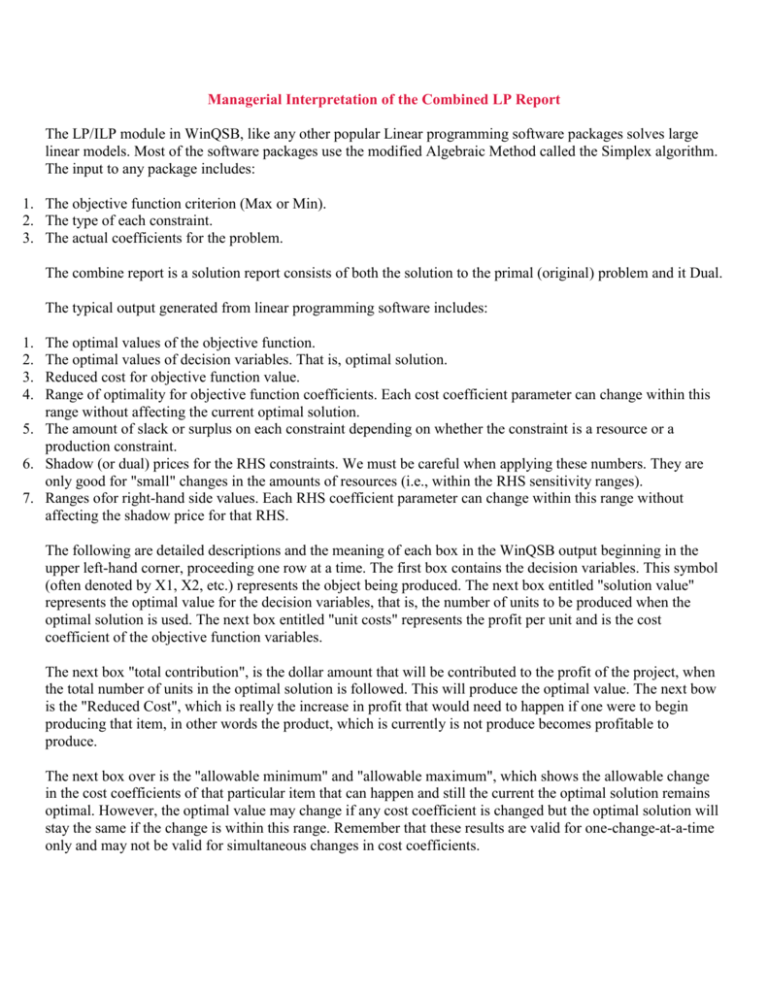
Managerial Interpretation of the Combined LP Report The LP/ILP module in WinQSB, like any other popular Linear programming software packages solves large linear models. Most of the software packages use the modified Algebraic Method called the Simplex algorithm. The input to any package includes: 1. The objective function criterion (Max or Min). 2. The type of each constraint. 3. The actual coefficients for the problem. The combine report is a solution report consists of both the solution to the primal (original) problem and it Dual. The typical output generated from linear programming software includes: 1. 2. 3. 4. The optimal values of the objective function. The optimal values of decision variables. That is, optimal solution. Reduced cost for objective function value. Range of optimality for objective function coefficients. Each cost coefficient parameter can change within this range without affecting the current optimal solution. 5. The amount of slack or surplus on each constraint depending on whether the constraint is a resource or a production constraint. 6. Shadow (or dual) prices for the RHS constraints. We must be careful when applying these numbers. They are only good for "small" changes in the amounts of resources (i.e., within the RHS sensitivity ranges). 7. Ranges ofor right-hand side values. Each RHS coefficient parameter can change within this range without affecting the shadow price for that RHS. The following are detailed descriptions and the meaning of each box in the WinQSB output beginning in the upper left-hand corner, proceeding one row at a time. The first box contains the decision variables. This symbol (often denoted by X1, X2, etc.) represents the object being produced. The next box entitled "solution value" represents the optimal value for the decision variables, that is, the number of units to be produced when the optimal solution is used. The next box entitled "unit costs" represents the profit per unit and is the cost coefficient of the objective function variables. The next box "total contribution", is the dollar amount that will be contributed to the profit of the project, when the total number of units in the optimal solution is followed. This will produce the optimal value. The next bow is the "Reduced Cost", which is really the increase in profit that would need to happen if one were to begin producing that item, in other words the product, which is currently is not produce becomes profitable to produce. The next box over is the "allowable minimum" and "allowable maximum", which shows the allowable change in the cost coefficients of that particular item that can happen and still the current the optimal solution remains optimal. However, the optimal value may change if any cost coefficient is changed but the optimal solution will stay the same if the change is within this range. Remember that these results are valid for one-change-at-a-time only and may not be valid for simultaneous changes in cost coefficients. The next line is the optimal value, i.e., and the value of objective function evaluated at optimal solution strategy. This line shows the maximum (or minimum) value that can be derived under the given the optimal strategy. The next line down contains the constraints; often C1, C2, etc. denote the constraints. Starting on the left-hand side the first box contains the symbol C1 that represents the first constraint. The next box is the constraint value. That is, the left-hand-side (LHS) of each C1 evaluated ate the optimal solution. The next box over is the "direction box", which is either greater than or equal to / less than or equal to, which are the direction of the each constraint. The next box is the right hand side value, which states the value that is on the right hand side of each constraint. The next box is the difference between RHS and LHS numerical values called the slack or surplus box. If it is slack, it will have a less than or equal to sign associated with it, which means there is leftover of resources/raw material. If there is a surplus it will have a greater than or equal to sign associated with it, which means that there are over production. Next box over is the shadow price. If any slack or surplus is not zero then its shadow price is zero, however the opposite statement may not be correct. A shadow price is the additional dollar amount that will be earned if the right hand side constraint is increased by one unit while remaining within the sensitivity limits for that RHS. The next two boxes show the minimum and maximum allowable for the right hand side constraints. The first box (minimum box) shows the minimum value that the RHS constraint can be moved to and still have the same current shadow price. The second box shows the maximum number that the constraint can be moved to and still have the same current shadow price. Recall that the shadow prices are the solution to the dual problem. Therefore, the allowable change in the RHS suggests how far each RHS can go-up or down while maintaining the same solution to the dual problem. In both cases the optimal solution to the primal problem and the optimal value may change. Combined Report for Carpenter Problem RANGES IN THAT THE OPTIMAL SOLUTION IS UNCHANGED Decision Solution Unit Cost or Total Variable Value Profit c(j) 1 X1 10.0000 2 X2 20.0000 Basis Allowable Allowable Contribution Cost Status Min. c(j) Max. c(j) 5.0000 50.0000 0 basic 1.5000 6.0000 3.0000 60.0000 0 basic 2.5000 10.0000 Objective Function (Max.) = Reduced 110.0000 RANGES IN THAT THE SHADOW PRICES IS UNCHANGED Left Hand Right Hand Slack Shadow Allowable Allowable Side or Surplus Price Min. RHS Max. RHS Constraint Side Direction 1 C1 40.0000 <= 40.0000 0 2.3333 25.0000 100.0000 2 C2 50.0000 <= 50.0000 0 0.3333 20.0000 80.0000

